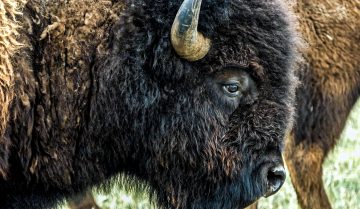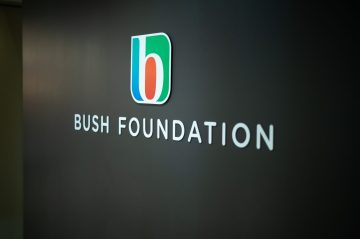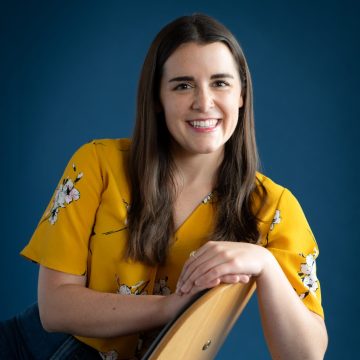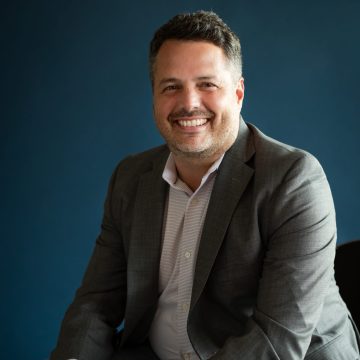Story
Growing the Herd
The Wolakota Project aims to reform the sacred union between buffalo and the Lakota people
DATE
July 26, 2021

By Marcie Rendon
The Lakota creation story describes how, in the beginning of time, beings emerged from the earth beneath the Black Hills in what is now known as South Dakota. There were some who took human form and others who took buffalo form. It was in this beginning that an inseparable bond formed between the buffalo nation and the Lakota human nation.
The legend describes how the buffalo became caregivers for humans, providing implements necessary for daily life: food, shelter, spiritual nurturance and connection. Meanwhile, the humans became the caretakers of the buffalo nation, taking only what they needed and honoring the rest. This symbiotic relationship, a close and mutually beneficial union between the two Lakota forms, is the underlying impetus for the Wolakota Buffalo Project, developed by the Sicangu Lakota Oyate (or Rosebud Sioux) Tribe.
In the early 1800s it is estimated that 60 million buffalo lived in North America. After a policy of genocide initiated by the United States government to wipe out the buffalo, fewer than 1,000 remained. “The genocide of the buffalo was intentional, deliberate,” says Wizipan Little Elk (BF’21), CEO of the Rosebud Economic Development Corporation (REDCO). He adds that it was a genocidal practice directed at the Lakota people. “Our main source of food, shelter, clothing and spiritual sustenance was taken from us. There is a very big justice component [to the Wolakota Project]. When we do the economic analysis, $2 trillion of wealth was extracted from our communities just in buffalo.”
The Wolakota Project intends to regenerate the buffalo nation while simultaneously creating a new Lakota economy. It would provide cultural opportunities by revitalizing the relationship with the buffalo, initiating environmental regeneration, combating climate change and strengthening food sovereignty.
“For every dollar of white wealth there is only 8 cents of Native wealth,” Little Elk adds. “There has been a mass extraction of our resources, which included the buffalo, but does not include our loss of horses, our shelter, our art or our land. Or the other dollar value of all the other resources extracted from our land. If we are going to tackle inequity in this part of the world we will need the buffalo.” He pauses. “Our real wealth is about cultural perpetuity: our ability to continue our way of life and pass it on to future generations.”
The Partnership
In a Lakota way of life, all things work together for the good of the whole. “This work is a continuation of many generations of work,” Little Elk says. “We as Lakota people have always been involved with the buffalo. They have always taken care of us. Now it is our turn to take care of them. This is not the first herd, and it is not the last herd.”
As a project created within that worldview, Wolakota is a tribal, governmental and public partnership serving a long-range vision to return and nurture buffalo on 28,000 acres of tribal land on the southwest corner of the Rosebud Reservation in south-central South Dakota. A five-year plan began in 2021 in partnership with the Tribal Land Enterprise (TLE), the World Wildlife Fund and the Department of Interior’s Bison Conservative Initiative.
REDCO, the economic arm of the Rosebud Tribe, will focus on developing leadership and creating economic opportunities that will generate revenue for the Sicangu Oyate and surrounding communities. It is within REDCO that Wolakota began its existence. The concept was originally conceived over the course of a little more than five years: plans were made, relationships solidified and formalized. In 2020 all the pieces fell into place for the project to move forward, and the Bush Foundation put forth a $2 million Community Innovation Grant to support the project.
In partnership with TLE, Wolakota was granted a 15-year lease to 28,000 acres that was previously cattle ranch land owned by former U.S. Supreme Court Justice Sandra Day O’Connor. The land was sold back to the Tribe when the property was divested. TLE, the purchaser, is a unique organization that was formed on the Rosebud Reservation in the 1940s as a measure to combat fractionalization of Indian lands. It buys back fractionated land, consolidates the land and prevents it from leaving Tribal ownership. The leased land is an ecosystem familiar to buffalo that fulfills their environmental needs to successfully live and propagate.
The longer-range vision encompasses everything from cultural ecotourism to an education-visitor center to accepting requests to host school trips and camps, which would mean creating a sustainable campground for visitors.
Ima
The first bison were donated to the Wolakota Buffalo Range through an agreement with the Department of the Interior and National Parks Service. The animals arrived in October 2020 from Badlands National Park and Theodore Roosevelt National Park. Wolakota has also received animal donations from American Prairie Reserve and The Nature Conservancy.
Image
The World Wildlife Fund, an NGO partner with a mission to “conserve nature and reduce the most pressing threats to the diversity of life on Earth,” provides technical and fundraising support to Wolakota. In the fall of 2020, the U.S. Department of the Interior, within the capacity of its Bison Conservative Initiative, donated 100 buffalo to Wolakota. These are the first of potentially 1,500 buffalo that can be sustained on the acreage.
The Land and Environment
The 28,000 acres of Wolakota-leased land is classic Nebraska sandhills with mixed prairie grass and pine hilltops, according to Aaron Epps, Wolakota marketing and communications director. The Little White River runs through the land of the Sicangu Lakota Oyate past sandy cliffs and creates a variety of different ecosystems throughout the range.
The reintroduction of a buffalo herd will help regenerate prairie plants and other animal species. Wolakota demonstrates the difference between cattle farms and bison herds. The vast majority of U.S. cattle are raised in feedlots and require inordinate amounts of ecological sustenance, whereas buffalo move across vast areas of land, fertilizing with their dung and urine to help decompose and enrich the soil. Buffalo herds preserve grasslands, which in turn can heighten the ability of the soil to retain carbon dioxide.
“I think that this project represents the next generation of work with buffalo,” says Epps. “It will be done at a large scale involving much larger acreage. And if we can secure hundreds of thousands of acres and take projects like ours and scale them up, we can take land and achieve conservation purposes. We can rewild these spaces and create economic change while combating climate change.”
Many Visions Aligned
Wolakota’s economic vision is more than just monetary. “When we think about the next generation of businesses that are needed in the world — a social perspective, justice perspective, climate perspective — we will need to have multiple bottom lines, not just a single bottom line,” says Epps. “Wolakota is a project to rebuild the ecosystem of the prairie, to reconnect the buffalo and the Lakota people. We want to create a new Lakota economy that will provide multiple opportunities for people.”
An overall goal is for the herd to become self-sufficient. They will live off the land, nurture the land and return to the people. They will feed the people of Rosebud and as the herd grows, their meat and other products will be sold to others outside the reservation.
In its first year of operation, Wolakota witnessed the birth of its first calves and also conducted its first community herd share. Buffalo were field harvested following traditional rituals. Use of the entire buffalo, in Lakota tradition, pays respect to the buffalo who has given of itself to the people. In keeping with that Lakota value, the harvested meat was donated to the community, and the hide and the skull were saved to be processed for traditional use.
The first five-year plan is to go from zero buffalo to full capacity for the land, and the potential for 300-400 surplus buffalo that will be harvested. The meat will be processed regionally until the core business is set up. Epps says that Wolakota is doing a feasibility study to build a meat-processing plant. They are also committed to a yearly measure of baseline soil and ecological data, which will study the impact of the buffalo on the return of the land to a native ecosystem.
As the herd grows, so will the business model. “We are exploring a couple models for growth,” says Epps. “One model might be a community herd-sharing program where we would fundraise for the cost and tribal members could purchase a share. A share might be three buffalo over a three-year period. Another model we have explored is to create a Rosebud-branded product which would involve selling to people or organizations off the reservation but subsidized to give back to the tribe.”
The longer-range vision encompasses everything from cultural ecotourism to an education-visitor center to accepting requests to host school trips and camps, which would mean creating a sustainable campground for visitors. In the summer of 2021, the Boys and Girls Club of Rosebud launched a pilot summer camp for youth to learn about the relationship between the Lakota and the buffalo. Projects like this will support Wolakota’s underlying vision to nurture and rebuild the connection between the two while promoting wellness, connection to the environment and healthy lifestyles.
In the late 1800s, it is estimated fewer than 1,000 buffalo remained alive in North America. (Video by Clay Bolt)
Investing in Social Impact
Little Elk and REDCO see the Wolakota Project as a continuation of many generations of work and a local solution using new ideas to address global challenges. To continue repairing centuries of disinvestment by forces outside Tribes, Little Elk is using his Bush Fellowship as an opportunity to better understand how to incorporate Indigenous beliefs into social impact investment models.
“We look to redefine wealth according to Lakota-Indigenous thought.” says Little Elk. “We need to rethink the ways we invest our money. [Wolakota] is the first generation of social investment impact projects. We are going to help set the stage for all kinds of work not just in Indian Country, but around the world.”
He mentions the recent news of multiple unmarked burial grounds discovered at the sites of Indigenous boarding schools across North America. “Our collective consciousness needs to see our awareness increased,” he says. “Just as there is a growing movement around that injustice, it informs our ability to have our cultural perpetuity.”
“Wizipan, as a leader, is pushing us forward in impact investing,” Epps says. “As investors we want to create more than a financial base. It is about sequestering carbon, creating jobs, creating opportunities with access to food, hides, skulls, traditional teachings — things that will impact us both socially and environmentally.”
In the future, the people of Rosebud and the surrounding communities have the potential to be Wolakota employees as well as benefit from the economic gain, food production, and cultural and spiritual aspects of the project. “We are doing something that has never been done,” said Little Elk in a Department of the Interior press release. “It shows what is possible when business, philanthropy and government work together to create multiple bottom-line initiatives supporting the environment, people, fiscal responsibility and Native nation building.”
Marcie Rendon is a citizen of the White Earth Nation. Oprah Magazine’s 2020 list of 31 Native American Authors to read. 2020 McKnight Distinguished Artist Award. 50over50 MN AARP & Pollen Award.
Continue reading
-

News
Opportunity to work with us
As part of our office move later this year, we are exploring possibilities for the build out of the ground floor of the building. We are in the early stages of this and considering different types of operating models and potential partnerships.
-

Staff note
Coordinating the work of our contact hub
We aim to be radically open in all that we do, and that includes being more accessible to more people and sharing what we learn along the way.
-

Staff note
Making every dollar work through impact investing
We have benefitted from the experience of other funders as we developed our impact investing approach. Now we are paying it forward and sharing what we have done and what we have learned.